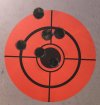I'm with CW, My Bullseye load is 3.5 unique with Lee 148 bnwc, crimped in the groove. We did a test of several 10 shot groups with each crimp with a smith 15 and an ultradot at 25 yds. First was no crimp just eliminate the belling. The next series of 1/4 turn each of the Lee FCD adjustment for a full turn from the no crimp position. The 3/4 position was the best by a longshot (pun intended). When we got back around to the starting point (1 full turn) the group almost doubled. The best ctc group measured .8 inches and the avg for that crimp was a tad over an inch. We used a round black aiming point just bigger than the ultradot's dot. Specs on that revolver and load is 4 inch factory barrel (taylor throated), cylinders reamed to .358. All brass was Federal wadcutter brass trimmed and all primer pocket reamed and flash holes were deburred. Federal spp.
Here is where it get interesting. Switch to r/p wadcutter brass with the same process applied, the second position is as tight as they would shoot. Almost can't see the crimp without a magnifying glass. Any more and the groups grew. Winchester wadcutter brass, I just couldn't get close to the other two no matter what I did.
When we switched powders to either Bullseye or HP-38 we had to do it all over again. Best I can tell the crimp is powder and charge level specific. One interesting thing that happened later is we switched to 20:1 alloy vs 94/2/4 alloy and the 20/1 is much more forgiving and not near as picky to loading techniques.
After all that work with wadcutters we all switched to the Lee 105 swc with HP-38, softer recoil and better accuracy at 50 yds and about the same at 25 yds.
I still keep several hundred rounds of w/c's for plinking in the non-target and cowboy guns as they shoot to the fixed sights of most 38's. In case anyone has a fast twist PPC revolver laying around they are accurate to 109 yds (100 Meters) rams with boring consistency. Mine is a Travis Strahan, but I haven't measured the twist.
Tony
Here is where it get interesting. Switch to r/p wadcutter brass with the same process applied, the second position is as tight as they would shoot. Almost can't see the crimp without a magnifying glass. Any more and the groups grew. Winchester wadcutter brass, I just couldn't get close to the other two no matter what I did.
When we switched powders to either Bullseye or HP-38 we had to do it all over again. Best I can tell the crimp is powder and charge level specific. One interesting thing that happened later is we switched to 20:1 alloy vs 94/2/4 alloy and the 20/1 is much more forgiving and not near as picky to loading techniques.
After all that work with wadcutters we all switched to the Lee 105 swc with HP-38, softer recoil and better accuracy at 50 yds and about the same at 25 yds.
I still keep several hundred rounds of w/c's for plinking in the non-target and cowboy guns as they shoot to the fixed sights of most 38's. In case anyone has a fast twist PPC revolver laying around they are accurate to 109 yds (100 Meters) rams with boring consistency. Mine is a Travis Strahan, but I haven't measured the twist.
Tony

